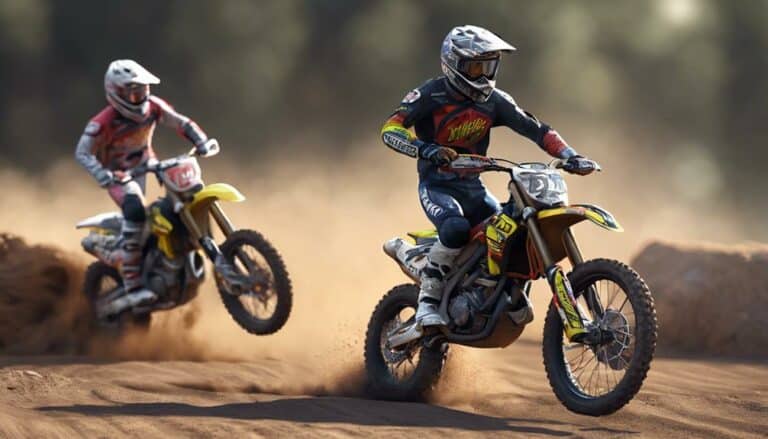When tackling various forms of dirt bike riding, you might find that the way you position your body plays an important role in your performance.
From the high-intensity demands of motocross to the endurance challenges of trail riding, each discipline requires specific body positioning techniques to navigate the terrain effectively.
Understanding these differences can make a significant impact on your ride, ensuring both skill enhancement and safety.
Key Takeaways
- Motocross riding requires leaning forward for control and balance, while trail riding involves shifting weight back on sandy terrain.
- Motocross emphasizes maximizing traction and stability during high-speed maneuvers, whereas trail riding focuses on adapting to varied terrains.
- Motocross riders lean back slightly to absorb impacts upon landing, while trail riders adjust body position forward on uphill terrain to prevent tipping.
- Motocross riders use body positioning to adjust to changing terrain, while trail riders actively adapt to obstacles for balance and control.
Body Positioning for Motocross Riding
When tackling motocross riding, expertly leaning forward is important for maintaining control and balance through sharp turns and jumps. In motocross, body positioning is vital for maximizing traction and stability during high-speed maneuvers. By keeping your weight centered over the bike, you can guarantee better control over the bike's movements.
As you navigate the trail, constantly adjust your body position to adapt to the changing terrain and obstacles. Leaning back slightly when landing from jumps allows you to absorb impacts and maintain stability. The aggressive stance and dynamic weight shifting required in motocross riding highlight the intense demands of racing on tracks.
To excel in motocross, focus on active engagement with your body position to handle the challenges presented by the fast-paced, unpredictable nature of the sport. Mastering these techniques will help you navigate the jumps and turns with finesse and confidence.
Body Positioning for Trail Riding
To enhance balance and control over the diverse terrains encountered, consider the following techniques:
- Shift Weight Back on Sandy Terrain: Keep the bike upright by shifting your weight slightly back on sandy terrain. Utilize your legs for balance, allowing you to maneuver smoothly while maintaining stability.
- Utilize Knees and Elbows for Shock Absorption on Rocky Terrain: When encountering rocky terrain, stand up on the bike with bent knees and elbows. This technique not only helps with shock absorption but also provides better control over the bike on rough surfaces.
- Adjust Body Positioning on Uphill Terrain: Shift your weight forward on uphill terrain to prevent tipping backward and maintain traction. This adjustment is essential for maintaining control and balance when tackling inclines during trail riding adventures.
Body Positioning on Flat Terrain
To achieve top control and stability on flat terrain while dirt bike riding, make sure your body remains centered with your chin positioned over the handlebars and elbows bent upward and outward for enhanced maneuverability.
On flat terrain, maintaining balance over the pivot point is critical for stability and control. By keeping a centered body position, you guarantee top balance and maneuverability on smoother surfaces. Distribute your weight evenly to maintain balance and control while riding on flat terrain.
Adjust your body positioning by keeping your elbows bent upward and outward to absorb impact and sustain stability. Proper body positioning on flat terrain involves having your chin over the handlebars, enabling you to control the bike effectively and prevent tipping.
Body Positioning on Uphill Terrain
Adjust your body positioning on uphill terrain by shifting your weight forward to maintain control and traction while preventing tipping backward. When riding uphill on a trail bike or Motocross Bike, your body positioning plays an important role in traversing the terrain effectively. Here are some key techniques to keep in mind:
- Lean Forward: Lean slightly forward to keep the front wheel grounded, ensuring traction and control during the climb.
- Stay Centered: Keep your body centered over the bike to avoid leaning too far back, which can lead to loss of control on inclines.
- Weight Distribution: Distribute your weight evenly towards the front of the bike to enhance stability and reduce the risk of wheel spin on uphill sections.
Body Positioning on Rocky Terrain
When traversing rocky terrain on a dirt bike, it's important to shift your weight back to keep the front wheel light. This technique helps maintain traction for improved control and maneuverability, reducing the chances of getting stuck or losing balance.
Standing on the footpegs is crucial on rocky terrain as it allows you to absorb impacts and let the bike maneuver over rocks smoothly. Additionally, leaning slightly forward can increase traction and stability, aiding in keeping the bike balanced on unpredictable rocky surfaces.
Using your knees and elbows as shock absorbers is vital to minimize the impact of rough terrain, providing better control over the bike. By practicing and adjusting your body positioning on rocky terrain, you can enhance your riding skills and confidently tackle challenging obstacles.
Conclusion
Congratulations on mastering the art of body positioning techniques for different types of dirt bike riding! Now you can confidently tackle any terrain with precision and skill.
Remember, it's not just about speed and jumps, but about finesse and control. So next time you hit the trails or the track, show off your expertise in a way that leaves others in awe.
Keep riding, keep improving, and keep pushing yourself to new heights in the world of dirt bike riding.

